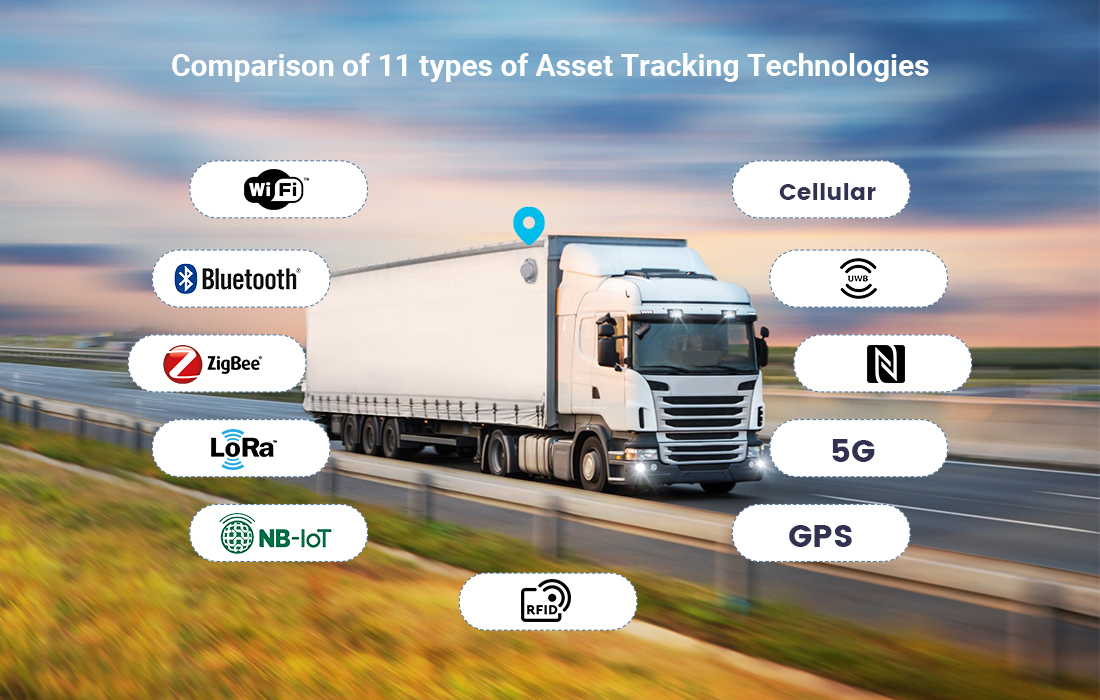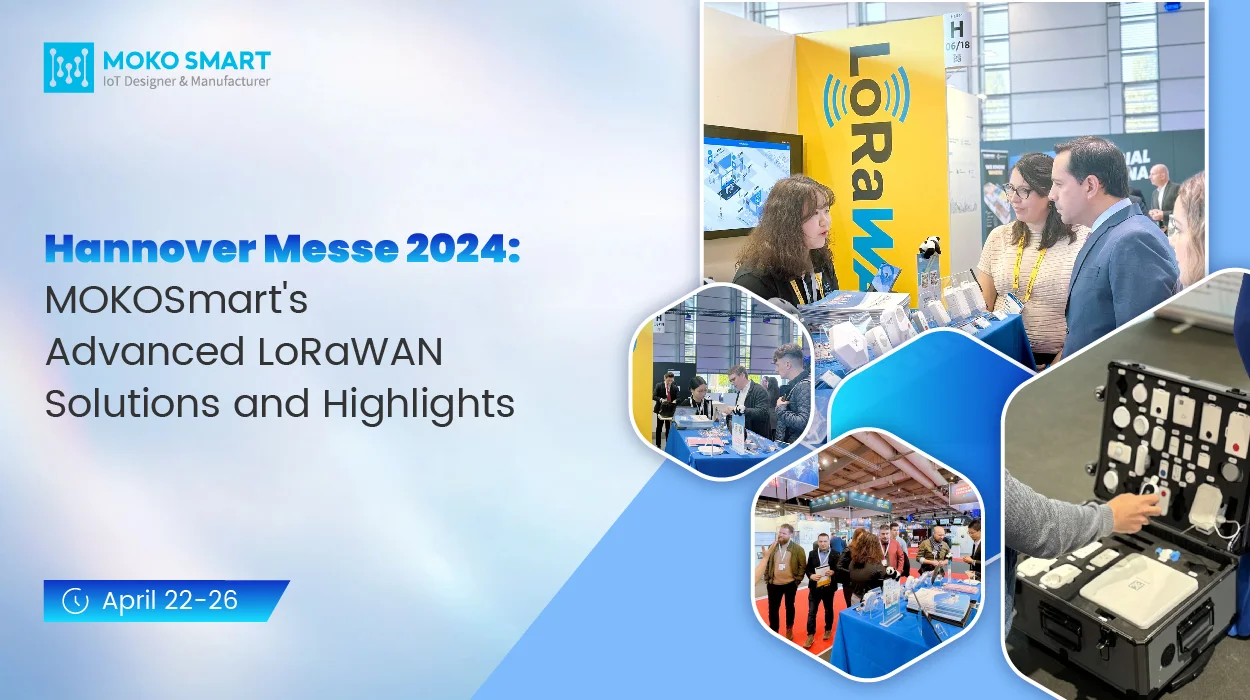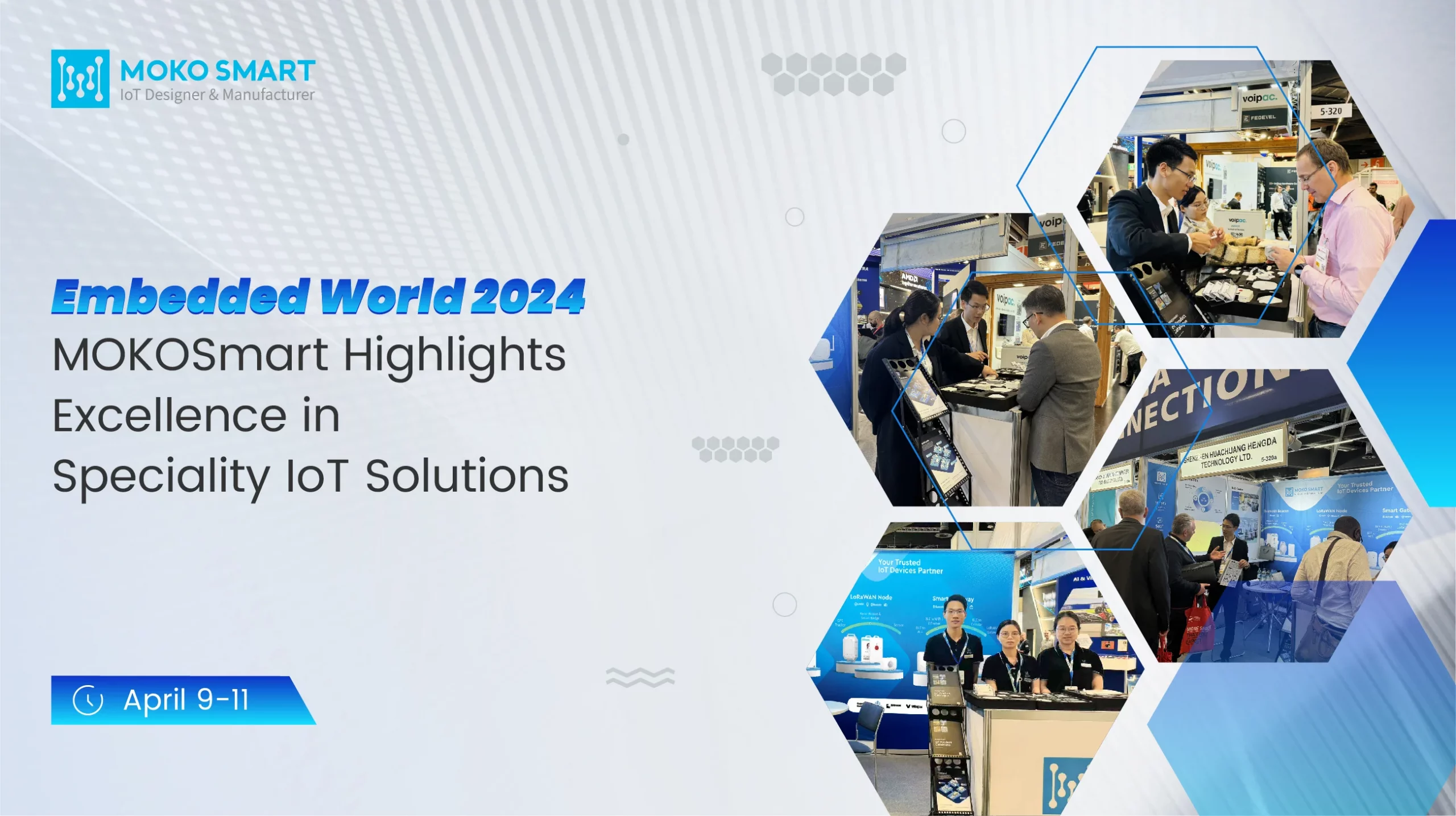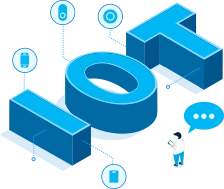As tecnologias de rastreamento de ativos servem como suporte fundamental para o gerenciamento de ativos e processos. No mercado hoje, há uma abundância de produtos de rastreamento de ativos que atendem a diferentes características e tecnologias. Ao comparar tecnologias de rastreamento de ativos, podemos pensar neles como folhas de uma árvore – talvez haja duas folhas que se parecem, mas não há dois exatamente iguais. Felizmente, em tecnologias de rastreamento de ativos, todos podem encontrar a tecnologia que atende às suas necessidades.
Neste artigo, forneceremos uma introdução detalhada a diversas aplicações diferentes de tecnologia sem fio, incluindo RFID, Baseado em GPS, Bluetooth, LoRa, NFC, Wi-fi, 5G, UWB, celular, NB-IoT, e Zigbee. Explorando suas funcionalidades e cenários de aplicação, podemos obter uma compreensão mais profunda das vantagens e da adequação de cada tecnologia para requisitos específicos de rastreamento. Finalmente, forneceremos vários fatores para sua consideração ao selecionar a tecnologia que melhor se adapta à sua aplicação de rastreamento de ativos.
UMA Ccomparação Tcapaz de a 11 Tipos de tecnologias de rastreamento de ativos
Para selecionar a tecnologia que melhor se adapta às nossas necessidades, vamos primeiro realizar uma análise aprofundada das principais tecnologias de rastreamento de ativos disponíveis no mercado atual por meio de estudos comparativos.
| Tecnologia | Alcance | Consumo de energia | Taxa de dados | Cobertura | Interferência | Custo | Inscrição |
|---|---|---|---|---|---|---|---|
| GPS | acesso global dentro da linha de visão do satélite | Moderado | Baixo | Exterior | Mínimo | Alto | Rastreamento de veículos, ativos |
| RFID | Curto | muito baixo | Baixo | Interior/ Curto |
Baixo | Moderado | Inventário A IoT desempenha um papel crítico no aumento da eficiência e na melhoria dos clientes, controle de acesso |
| Bluetooth | Curto (até 100 m) | Baixo | Médio | Interior/ Curto |
Moderado | Baixo | Item pessoal monitorando, detecção de proximidade |
| LoRa | Longo (até vários km) | muito baixo | Baixo | Ar livre/ Longo |
Mínimo | Baixo | Acompanhamento de bens, cidades inteligentes |
| NFC | Curto (Apenas alguns centímetros) | muito baixo | Baixo | Muito curto | Baixo | Baixo | Sem contato pagamentos, controle de acesso |
| Wi-fi | Médio | Médio | Alto | Interior | Moderado | Moderado | Ativo interno monitorando, casas inteligentes |
| 5G | Global | Moderado a Alto | Alto | Ar livre/ Interior |
Mínimo a Alto | Alto | Transmissão de dados em alta velocidade, Aplicativos IoT |
| UWB | Curto (até 100 m) | Baixo | Alto | Interior | Mínimo | Alto | Interior preciso posicionamento, rastreamento de ativos |
| Celular | Global | Moderado a Alto | Médio | Ar livre/ Interior |
Mínimo a Alto | Moderado a Alto | Gestão de frota, logística |
| NB-IoT | Global | Baixo | Baixo | Ar livre/ Interior |
Mínimo a Moderado | Baixo | IoT de baixo consumo de energia formulários |
| Zigbee | Curto a médio | Baixo | Baixo | Interior/ Curto |
Moderado | Baixo | Automação residencial, Industrial formulários |
Ddetalhado Informações relativas a 11 Tipos de tecnologias de rastreamento de ativos
Rastreamento de ativos GPS
O rastreamento de ativos por GPS utiliza a tecnologia do Sistema de Posicionamento Global para monitorar e rastrear com precisão a localização dos ativos em tempo real. Oferece informações de localização precisas e confiáveis, tornando-o adequado para rastrear ativos que são frequentemente móveis ou situados em ambientes externos. Em comparação com outras tecnologias, O rastreamento de ativos por GPS tem taxas de transmissão mais lentas e é mais caro que outras tecnologias, mas oferece ampla cobertura e capacidades de posicionamento global, tornando-o ideal para aplicações como gerenciamento de frota, logística, e operações da cadeia de suprimentos.
MOKOSmart's GPS Rastreamento de ativos
Os produtos de rastreamento de ativos GPS da MOKOSmart incluem o LWO01-BG PRO Rastreador GPS e mais. Esses produtos de rastreamento de ativos são usados principalmente em cenários externos, como rastreamento de veículos e ativos.. Esses produtos são muito procurados por muitas empresas devido aos seguintes recursos:
- Suporta posicionamento interno e externo
- Suporte para correção offline
- Backup de dados locais para cargas úteis de uplink
Rastreamento de ativos RFID
RFID (Identificação de rádio frequencia) o rastreamento de ativos usa ondas de rádio para identificar e rastrear ativos equipados com etiquetas RFID. As etiquetas RFID são equipadas com identificadores distintos que podem ser detectados e lidos por leitores ou scanners RFID. Esta tecnologia permite identificação e rastreamento rápido e automatizado de ativos, eliminando a necessidade de entrada manual de dados. O rastreamento de ativos RFID é adequado para vários setores, como varejo, fabricação, e cuidados de saúde, onde o gerenciamento eficiente de estoque e o rastreamento em nível de item são essenciais. Comparado ao GPS, RFID tem um alcance menor, mas oferece melhor precisão para identificação de ativos próximos.
MOKOSmart's RFID Rastreamento de ativos
Os produtos de rastreamento de ativos RFID da MOKOSmart incluem o H5 Farol RFID, entre outros. Esses produtos de rastreamento de ativos são usados principalmente em ambientes internos, cenários de curto prazo, como gerenciamento de estoque e controle de acesso. Esses produtos são muito procurados por muitas empresas devido aos seguintes recursos:
- Chipset de consumo de energia ultrabaixo Série NRF52.
- 6 slots que podem ser configurados.
- Frequência RFID de 13,56 MHz, com uma distância de detecção de telefone celular de 5 mm e uma distância de detecção de leitor de cartão de 40 mm.
- Opções de configuração para valor G, taxa de amostragem, e sensibilidade do sensor do acelerômetro de 3 eixos.
Rastreamento de ativos Bluetooth
O rastreamento de ativos Bluetooth utiliza tecnologia Bluetooth para estabelecer conexões sem fio de curto alcance entre ativos e dispositivos de rastreamento. Facilita o rastreamento de ativos dentro de uma distância restrita, normalmente atingindo um máximo de 100 metros. O rastreamento de ativos Bluetooth é comumente usado para cenários internos de rastreamento de ativos, como em armazéns, hospitais, ou lojas de varejo, onde o rastreamento de perto é suficiente. Fornece eficiência energética, acessibilidade, e compatibilidade com uma ampla gama de dispositivos. Contudo, suas limitações de alcance o tornam menos adequado para rastreamento externo ou de longo alcance em comparação com GPS ou rastreamento celular.
MOKOSmart's Rastreamento de ativos Bluetooth
Os produtos de rastreamento de ativos BLE da MOKOSmart incluem H2 Beacon de navegação, M2 Sinalizador de Rastreamento de Ativos, M3 Beacon Industrial, M4 Etiqueta leve, e mais. Esses produtos de rastreamento de ativos são amplamente utilizados em cenários internos de curto alcance, como rastreamento de itens pessoais e detecção de proximidade.. Esses produtos são muito procurados por muitas empresas devido aos seguintes recursos:
- Custo-beneficio – A coleta precisa de dados traz alto ROI.
- Alta capacidade – Entregar 800% mais capacidade de transmissão de mensagens.
- Alta precisão – 0.1 para 0.5 metros
- Bateria de longa duração – até 5 anos
- Tamanho pequeno
- Transferência rápida de dados – Quase duas vezes mais rápido que outras tecnologias de curto alcance.
- Instalação fácil – Nenhuma infraestrutura extra é necessária.
- Segurança aprimorada – Os sinais BLE são transmitidos através de uma rede celular segura.
Rastreamento de ativos LoRa
LoRa (Longo alcance) o rastreamento de ativos utiliza um baixo consumo de energia, rede de área ampla (LPWAN) tecnologia chamada LoRaWAN. Oferece capacidades de comunicação de longo alcance com baixo consumo de energia, tornando-o adequado para rastrear ativos em grandes áreas. O rastreamento de ativos LoRa é ideal para aplicações como agricultura, cidades inteligentes, e monitoramento industrial, onde os ativos estão espalhados por vastas áreas e exigem conectividade de longo alcance. Comparado ao GPS ou rastreamento celular, LoRa fornece uma solução econômica para baixo consumo de energia, rastreamento de ativos de longo alcance, mas com menor precisão e recursos de rastreamento em tempo real.
MOKOSmart'Rastreamento de ativos LoRa
MOKOSmart oferece uma seleção de soluções de rastreamento de ativos que utilizam tecnologia LoRa. Essas soluções abrangem o Rastreador GPS LWO01-PG PRO, LW004-PB Botão de pânico, LoRaWAN Botão Informações, LW008-MT Pequeno LoRaWAN Rastreador, e vários outros produtos de última geração. Esses produtos de rastreamento de ativos são amplamente utilizados em cenários remotos externos, como rastreamento de ativos e cidades inteligentes.. Esses produtos são altamente preferidos por muitas empresas devido aos seguintes recursos:
- Cobertura em ambientes desafiadores- Oferecer cobertura em áreas rurais até 60 quilômetros de distância ou em ambientes de difícil acesso, como áreas urbanas densas ou ambientes fechados.
- Operação sem licença – O sistema LoRa opera em frequências não licenciadas, eliminando a necessidade de taxas de licenciamento exigidas em bandas celulares licenciadas.
- Simplicidade e facilidade de implantação – Simples de implantar e configurar, tornando conveniente para as empresas implementá-los em suas operações.
Rastreamento de ativos NFC
NFC (Near Field Communication) rastreamento de ativos é uma tecnologia de comunicação sem fio de curto alcance que permite que dispositivos estabeleçam uma conexão aproximando-os. Permite comunicação segura e sem contato entre dispositivos, tornando-o adequado para aplicações como controle de acesso, pagamentos sem contato, e rastreamento de ativos em pequena escala. O rastreamento de ativos NFC oferece identificação rápida e conveniente de ativos, mas tem alcance limitado e requer proximidade, tornando-o menos adequado para rastreamento de longo alcance ou externo em comparação com GPS ou RFID.
Rastreamento de ativos WiFi
O rastreamento de ativos WiFi aproveita a infraestrutura WiFi existente para rastrear e monitorar ativos dentro da área de cobertura das redes WiFi. Utiliza sinais WiFi e técnicas de triangulação para estimar a localização dos ativos. O rastreamento de ativos WiFi é adequado para ambientes internos, como escritórios, hospitais, ou espaços comerciais onde redes WiFi estão disponíveis. Ele fornece um nível relativamente alto de precisão e pode ser perfeitamente incorporado em redes WiFi existentes. Contudo, sua cobertura é limitada ao alcance das redes WiFi, tornando-o menos adequado para rastreamento de ativos externos ou em grande escala em comparação com GPS ou tecnologias celulares.
5Rastreamento de ativos G
5O rastreamento de ativos G utiliza a última geração de tecnologia de rede celular, 5G, para rastrear e monitorar ativos. Oferece transmissão de dados em alta velocidade, baixa latência, e aumento da capacidade da rede, permitindo rastreamento de ativos em tempo real e aplicativos avançados, como AR e VR. 5O rastreamento de ativos G é adequado para vários setores, incluindo logística, transporte, e cidades inteligentes, onde a conectividade rápida e confiável é crucial. Em comparação com gerações anteriores de tecnologias celulares, 5G fornece desempenho aprimorado, cobertura de rede melhorada, e melhor suporte para implantações massivas de IoT.
Rastreamento de ativos UWB
O rastreamento de ativos UWB utiliza tecnologia de banda ultralarga para rastrear e localizar ativos com precisão em tempo real. UWB emite curto alcance, ondas de rádio de alta frequência que permitem posicionamento preciso com precisão centimétrica. É adequado para aplicações que exigem rastreamento de ativos altamente preciso, como a produção industrial, cuidados de saúde, e navegação interna. O rastreamento de ativos UWB oferece precisão superior em comparação com outras tecnologias sem fio, como GPS ou Bluetooth, mas normalmente opera em distâncias mais curtas.
Rastreamento de ativos celulares
O rastreamento de ativos celulares utiliza redes celulares para rastrear e monitorar ativos. Baseia-se na comunicação celular para transmitir dados de localização e informações de ativos. O rastreamento de ativos celulares é adequado para ativos que exigem cobertura e mobilidade de área ampla, à medida que aproveita a infraestrutura celular existente. É comumente usado para rastreamento de veículos, gestão de frota, e monitoramento de ativos em locais remotos. Em comparação com outras tecnologias, o rastreamento de celular oferece cobertura mais ampla e melhor escalabilidade, mas pode ter maior consumo de energia e custos de rede associados.
MOKOSmart's Rastreamento de ativos celulares
Os produtos de rastreamento de ativos celulares da MOKOSmart incluem AT001 Rastreador de ativos, GT001 Rastreador de monitor de mercadorias, VT001 Rastreador de veículo, e mais. Esses produtos de rastreamento de ativos são amplamente utilizados em cenários externos, como gerenciamento de frota e logística. Esses produtos são altamente preferidos por muitas empresas devido aos seguintes recursos:
- Equipado com GNSS multiconstelação
- Espera ultra longa
- T&Monitoramento H
- Plataforma de dados visuais
- Motor de controle remoto
Rastreamento de ativos NB-IoT
O rastreamento de ativos NB-IoT é um recurso de baixo consumo de energia, tecnologia de rede de área ampla projetada para aplicações IoT. Oferece cobertura estendida em distâncias significativas enquanto consome energia mínima, tornando-o adequado para rastrear ativos em áreas extensas. O rastreamento de ativos NB-IoT é ideal para aplicações como logística, agricultura, e monitoramento ambiental, onde a longa duração da bateria e a cobertura estendida são essenciais. Comparado com outras tecnologias celulares, NB-IoT oferece melhor eficiência energética, vida útil prolongada da bateria, e menores custos de implantação.
Rastreamento de ativos Zigbee
O rastreamento de ativos Zigbee utiliza o protocolo sem fio Zigbee, que é projetado especificamente para baixa potência, comunicação de curta distância. Zigbee facilita a conexão e comunicação entre dispositivos dentro de uma topologia de rede mesh. É comumente usado em automação residencial, edifícios inteligentes, e aplicações de monitoramento industrial. Oferece baixo consumo de energia, escalabilidade, e custo-benefício. Contudo, seu alcance é limitado em comparação com outras tecnologias como GPS ou celular, tornando-o mais adequado para cenários de rastreamento de ativos internos ou localizados.
GPS versus RFID versus BBluetooth vs LoRa vs NFC vs WIFI vs 5G vs UWB vs Celular vs NB-IoT vs Zigbee: Wqual é melhor?
Cada tecnologia de rastreamento de ativos tem suas próprias características e vantagens e desvantagens, então vamos dar uma olhada em suas vantagens e desvantagens, e usar alguns fatores para determinar a tecnologia mais adequada para nós.
GPS versus RFID versus BBluetooth vs LoRa vs NFC vs WIFI vs 5G vs UWB vs Celular vs NB-IoT vs Zigbee: Prós e contras
Prós e contras de GPS Rastreamento de ativos
Prós
- Gama global
- Baixo consumo de energia
- Precisão média
- Rastreamento em tempo real
- Praticamente livre de interferências
- A visibilidade global dos ativos rastreados
- Os sistemas de rastreamento de ativos baseados em GPS podem ser facilmente expandidos simplesmente anexando tags GPS aos ativos.
- Extensa coleção de aplicativos confiáveis de rastreamento GPS.
- Integração GPS em muitos dispositivos profissionais e de consumo.
- Potencial infinito para escalabilidade e sensores confiáveis.
- Você pode configurar notificações dentro de um limite geográfico especificado.
Contras
- Limitado a ambientes externos
- Precisão do nível do medidor- baixa precisão de 10 para 33 ft.
- Alto consumo de energia
- O GPS pode ser menos confiável em áreas com paisagens acidentadas ou perto de edifícios altos.
- Os usuários finais não podem reparar ou ajustar o espaço ou controlar segmentos
- Hardware caro- O custo de aquisição de dispositivos de rastreamento GPS para cada ativo individual pode variar dependendo do número de ativos que você pretende equipar.
Prós e contras do rastreamento de ativos RFID
Prós
- Não é necessária bateria
- Longa longevidade do dispositivo
- Tags pequenas – especialmente as passivas
- Assinatura de rádio pequena
- Várias opções de baixo custo para tags
Contras
- Baixa precisão
- Variabilidade de precisão
- Problemas de bateria com grandes implantações de tags ativas
- Incapacidade de fornecer dados de localização em tempo real
- Alta interferência – A tecnologia RFID passiva tem alta interferência de metais e líquidos.
- Instalações de sistemas complexos, às vezes exigindo verificações manuais
- Leitores de custo mais alto
Prós e contras do Bluetooth Rastreamento de ativos
Prós
- Ampla faixa de leitura de 100 para 270 ft
- Baixo consumo de energia
- Precisão de até alguns metros
- Atualizações em tempo real
- Ampla padronização
- Funcionalidade cruzada com dispositivos de consumo comuns
- Compatibilidade com infraestrutura existente
- Fácil de gerenciar – Os leitores BLE são geralmente mais baratos que os leitores de outras tecnologias. Como a maioria dos smartphones vem com capacidade Bluetooth, não há necessidade de adquirir equipamentos excessivos, e em alguns casos, os próprios smartphones podem ser usados para a tarefa.
Contras
- Curto alcance
- Latência média
- Risco de interferência de dispositivos no espectro de frequência compartilhado
- Vulnerabilidades de segurança
- A interferência pode levar à perda de pontos de dados
- As soluções BLE não funcionam bem em ambientes altamente desordenados com um grande número de metais ou superfícies reflexivas e ambientes onde peças móveis causam interferência.
- Requer uma alta densidade de transmissores- Garanta cobertura adequada e detecção de proximidade em ambientes grandes ou complexos.
Prós e contras do LoRa Rastreamento de ativos
Prós
- Longo alcance
- Baixo consumo de energia
- Custo-beneficio
- Escalabilidade
- Rastreamento interno e externo
Vigaristas
- Taxas de dados mais baixas
- Largura de banda limitada
- Falta de padronização global
Prós e Contras do NFC Rastreamento de ativos
Prós
- Tempo de configuração rápido
- Etiquetas baratas
- A digitalização é minimamente afetada pelo uso da etiqueta.
- As etiquetas NFC podem ser digitalizadas por dispositivos de consumo equipados com tecnologia NFC, como smartphones e laptops.
- A curta distância de trabalho torna o NFC adequado para aplicações de alta densidade.
- Capaz de integração perfeita com infraestruturas RFID passivas pré-existentes.
Contras
- Alcance de leitura curto
- Não é possível rastrear a localização de ativos em um espaço 2D ou 3D.
Prós e Contras do Wi-fi Rastreamento de ativos
Prós
- Rastreamento de localização em tempo real
- São necessários menos sistemas de ponte de dados
- Alcance de 60-100 metros
- Alta taxa de transferência de dados
- Capacidade de colaborar com uma ampla variedade de dispositivos habilitados para WiFi
- Operabilidade potencial com redes WiFi existentes, reduzindo custos de instalação
- A padronização WiFi simplifica o desenvolvimento e a interoperabilidade
- baixos custos de implementação
Contras
- Falta de escalabilidade
- Imprecisão- apenas para dentro 15 metros
- Tags consomem muita energia
- Congestionamento de redes WiFi existentes
- Alguns riscos de segurança contínuos
- Não escala
Prós e Contras do 5G Rastreamento de ativos
Prós
- Maior cobertura
- Alta velocidade e baixa latência
- Densidade aprimorada do dispositivo- 5As redes G podem suportar um grande número de dispositivos conectados em uma área específica. Isso permite que as empresas rastreiem um grande número de ativos simultaneamente, tornando-o adequado para indústrias com extensos portfólios de ativos.
- Confiabilidade aprimorada- 5As redes G fornecem maior confiabilidade de rede, garantindo conectividade consistente para aplicativos de rastreamento de ativos.
Contras
- Disponibilidade limitada- Áreas remotas ou menos desenvolvidas podem não ser cobertas.
- Desafios de compatibilidade- A atualização dos sistemas ou dispositivos de rastreamento de ativos existentes para serem compatíveis com a tecnologia 5G pode representar desafios de compatibilidade.
- Requisitos de infraestrutura- 5O rastreamento de ativos G depende da disponibilidade da infraestrutura de rede 5G, incluindo torres, estações base, e equipamentos de rede. Estabelecer e manter esta infraestrutura pode ser caro e demorado, especialmente em regiões com disponibilidade de rede restrita.
Prós e Contras do UWB Rastreamento de ativos
Prós
- Permite maior precisão de localização, geralmente em centímetros
- Altamente eficiente em termos de energia – Tags UWB de baixa taxa de dados exibem ciclos de baixa atividade, resultando em requisitos mínimos de consumo de energia.
- Transmissão de dados através de inúmeras paredes e obstáculos.
- Atualizações em tempo real
- Não causa interferência com a maioria dos outros sinais e dispositivos de RF.
- Assinaturas de rádio distintas e capacidade aprimorada para mitigar propagação multipercurso.
- Mais resistente à interferência multipercurso – Como os pulsos UWB são muito curtos, pulsos refletidos têm menos probabilidade de interferir com o pulso “verdadeiro” usado para medir a localização.
Contras
- Restrições de intensidade do sinal
- Padrões e protocolos menos maduros para interoperabilidade
- Dependência geral da sincronização de tempo para localização e rastreamento
- Muitas vezes requer mais energia do que outras tecnologias de rastreamento sem fio
- Limites baixos de emissões
- O cabeamento é necessário para sincronização de dados e hora – Ao utilizar pulsos UWB para obter medições TDoA precisas, é essencial sincronizar o tempo entre os sensores. Este processo de sincronização requer o uso de cabos.
- Caro – Os sistemas UWB incorrem em despesas mais elevadas em comparação com os sistemas RFID, pois necessitam de uma rede de sensores para cobrir áreas e fonte de alimentação ativa para as tags.
Prós e Contras do Celular Rastreamento de ativos
Prós
- Longo alcance – Alcance quase global
- Ampla padronização
- Base tecnológica cuidadosamente examinada e verificada
Contras
- Requisitos de energia muito altos
- Baixa precisão de rastreamento
- Uso limitado em locais internos ou subterrâneos
- Potencial para zonas mortas de sinal em áreas com cobertura de sinal limitada.
- Os usuários finais dependem de terceiros para cobertura de rede e não têm a capacidade de restaurar o sistema em situações em que a cobertura é perdida.
Prós e Contras do NB-IoT Rastreamento de ativos
Prós
- Baixo consumo de energia
- Ampla cobertura
- Custo-beneficio
- Conectividade confiável
Contras
- Largura de banda limitada
- Maior latência
- Cobertura de rede
Prós e Contras do Zigbee Rastreamento de ativos
Prós
- Baixo consumo de energia
- Custo-beneficio
- Interoperabilidade
- Rede mesh- Permite rastreamento confiável de ativos em ambientes complexos com obstáculos ou interferência de sinal e amplia o alcance da rede.
Contras
- Faixa limitada
- Baixa taxa de dados
- Interferência de outros dispositivos operando na mesma faixa de frequência.
GPS versus RFID versus BBluetooth vs LoRa vs NFC vs WIFI vs 5G vs UWB vs Celular vs NB-IoT vs Zigbee: Fator Cconsideração
A tecnologia de rastreamento de ativos mais adequada depende de vários fatores, incluindo a natureza dos ativos monitorados, o nível de precisão desejado, a escala da implantação, o ambiente de rastreamento, e o orçamento disponível. Ao escolher tecnologias de rastreamento de ativos, Há vários fatores a serem considerados:
Precisão de localização necessária: O nível de precisão de localização necessário depende dos requisitos específicos de rastreamento dos ativos. Por exemplo, se alta precisão é essencial, Sistemas de rastreamento de ativos baseados em GPS e UWB podem fornecer informações precisas de localização em tempo real.
Objetos para rastrear: O tipo e as características dos objetos rastreados influenciarão a escolha da tecnologia. Para ativos pequenos e leves, Rastreamento de ativos RFID ou rastreamento de ativos NFC podem ser adequados. Essas tecnologias são comumente usadas para rastrear itens como estoque, Ferramentas, ou pertences pessoais. O rastreamento de ativos Bluetooth também é versátil e pode rastrear vários objetos, incluindo dispositivos, equipamento, ou ativos dentro de uma faixa de proximidade.
O número de objetos a serem rastreados: A escalabilidade da solução de rastreamento é importante quando se considera o número de ativos a serem monitorados. Tecnologias como RFID e Bluetooth podem lidar com um grande número de ativos simultaneamente, tornando-os adequados para rastrear um grande volume de objetos.
Valor dos ativos monitorados: O valor dos ativos rastreados pode influenciar a escolha da tecnologia. Para ativos de alto valor, soluções de rastreamento mais robustas e seguras, como rastreamento de ativos celulares ou rastreadores baseados em GPS, pode ser preferível para garantir a sua protecção.
Considerações orçamentárias: O orçamento alocado para rastreamento de ativos é um fator crucial na determinação da escolha tecnológica adequada. Diferentes tecnologias variam em custo, e as empresas precisam avaliar os seus recursos financeiros e escolher uma solução que caiba no seu orçamento. Tecnologias como rastreamento de ativos Bluetooth, Rastreamento de ativos RFID, ou rastreamento de ativos por Wi-Fi costumam ser opções mais econômicas em comparação ao rastreamento de ativos por GPS ou rastreamento de ativos por celular.
Escalabilidade e planos de expansão futuros: Considere o crescimento potencial de suas necessidades de rastreamento de ativos. Escolha uma tecnologia que possa ser dimensionada à medida que sua empresa se expande. Soluções como LoRa, que oferecem recursos de longo alcance e baixo consumo de energia, são adequados para implantações escaláveis.
Integração com sistemas existentes: Avalie a compatibilidade da tecnologia selecionada com seus sistemas atuais. A compatibilidade com sua infraestrutura e plataformas de software é crucial para uma integração perfeita de dados e um gerenciamento simplificado de ativos. As tecnologias de rastreamento de ativos Bluetooth e Wi-Fi costumam ser facilmente integradas à infraestrutura de TI existente.
Requisitos de segurança e privacidade de dados: Avalie as necessidades de segurança e privacidade de dados da sua organização. Tecnologias como rastreamento de ativos celulares e NB-IoT fornecem comunicação segura e protocolos de criptografia, garantindo a confidencialidade dos dados de ativos rastreados.
Por que o rastreamento de ativos é essencial?
Simplificando processos de inventário: Os sistemas de rastreamento de ativos fornecem visibilidade em tempo real e dados precisos sobre localizações e quantidades de ativos. Isso agiliza os processos de gerenciamento de estoque, permitindo que as empresas rastreiem com eficiência, localizar, e gerenciar seus ativos. Automatizando contagens de estoque, elimina a necessidade de rastreamento manual, minimizando erros e economizando tempo valioso.
Minimizar custos associados a itens perdidos ou roubados. O rastreamento de ativos ajuda a prevenir a perda ou roubo de ativos valiosos. Ao implementar tecnologias de rastreamento, as empresas podem monitorar movimentos de ativos, configurar alertas para atividades não autorizadas, e recuperar rapidamente itens perdidos ou roubados. Isto reduz o impacto financeiro associado à substituição de ativos perdidos e ajuda a proteger os resultados financeiros.
Limitar perdas por encolhimento ou deterioração em ativos com datas de vencimento: O rastreamento de ativos torna-se crucial para ativos com datas de vencimento, como produtos perecíveis ou medicamentos. Rastreando datas de vencimento e implementando alertas automatizados, as empresas podem minimizar perdas por encolhimento ou deterioração, garantindo o consumo ou descarte oportuno de ativos antes que expirem.
Identificando erros nos processos de trabalho: Os sistemas de rastreamento de ativos fornecem insights sobre os processos de trabalho e podem ajudar a identificar ineficiências ou erros. Através da análise de dados sobre movimentação de ativos, as empresas podem identificar áreas de congestionamento, agilizar processos, e otimizar a alocação de recursos. Em última análise, isso resulta em maior eficiência operacional e benefícios financeiros.
Maximizando as horas de trabalho para aqueles encarregados de encontrar itens perdidos: O rastreamento de ativos elimina a tarefa demorada de procurar itens perdidos ou perdidos. Com dados de localização precisos, os funcionários podem localizar ativos rapidamente, economizando horas de trabalho valiosas que podem ser direcionadas para atividades mais produtivas.
Aumentar a produção de trabalho e a receita geral: Gerenciando ativos de forma eficaz, as empresas podem garantir que os ativos certos estejam disponíveis na hora certa e no lugar certo. Isso maximiza a produção de trabalho, reduz o tempo de inatividade, e aumenta a produtividade geral. A melhoria da gestão de ativos contribui para aumentar a geração de receitas e a satisfação do cliente.
Onde precisa de rastreamento de ativos?
Aqui estão alguns casos de uso comuns para rastreamento de ativos, juntamente com as tecnologias sem fio adequadas para cada aplicação:
Rastreamento de ferramentas
– Caso de uso: Ferramentas e equipamentos de rastreamento em setores como construção, fabricação, ou manutenção.
– Tecnologias sem fio adequadas: RFID, Bluetooth, LoRa, Celular.
Rastreamento de itens pessoais
– Caso de uso: Rastreamento de pertences pessoais, como carteiras, chaves, ou bolsas.
– Tecnologias sem fio adequadas: Bluetooth, NFC.
Gestão de Frota de Veículos
– Caso de uso: Rastreamento e gerenciamento de uma frota de veículos para fins logísticos ou de transporte.
– Tecnologias sem fio adequadas: GPS, Celular.
Controle de acesso de veículos
– Caso de uso: Monitoramento e controle de acesso a veículos, como carros alugados ou veículos compartilhados.
– Tecnologias sem fio adequadas: NFC, Bluetooth.
Rastreamento de contêineres
– Caso de uso: Rastreamento de contêineres durante operações de transporte e logística.
– Tecnologias sem fio adequadas: GPS, Celular.
Avaliando a utilização do equipamento
– Caso de uso: Otimizando a utilização de equipamentos em setores como manufatura ou construção.
– Tecnologias sem fio adequadas: RFID, Bluetooth, LoRa, Celular.
Gerenciamento de pátio
– Caso de uso: Gerenciando ativos e estoque em um armazém ou pátio de armazenamento.
– Tecnologias sem fio adequadas: RFID, Bluetooth, LoRa.
Cuidados de saúde
– Caso de uso: Rastreamento de equipamentos médicos, dispositivos, ou ativos de pacientes em instalações de saúde.
– Tecnologias sem fio adequadas: RFID, Bluetooth, Celular.
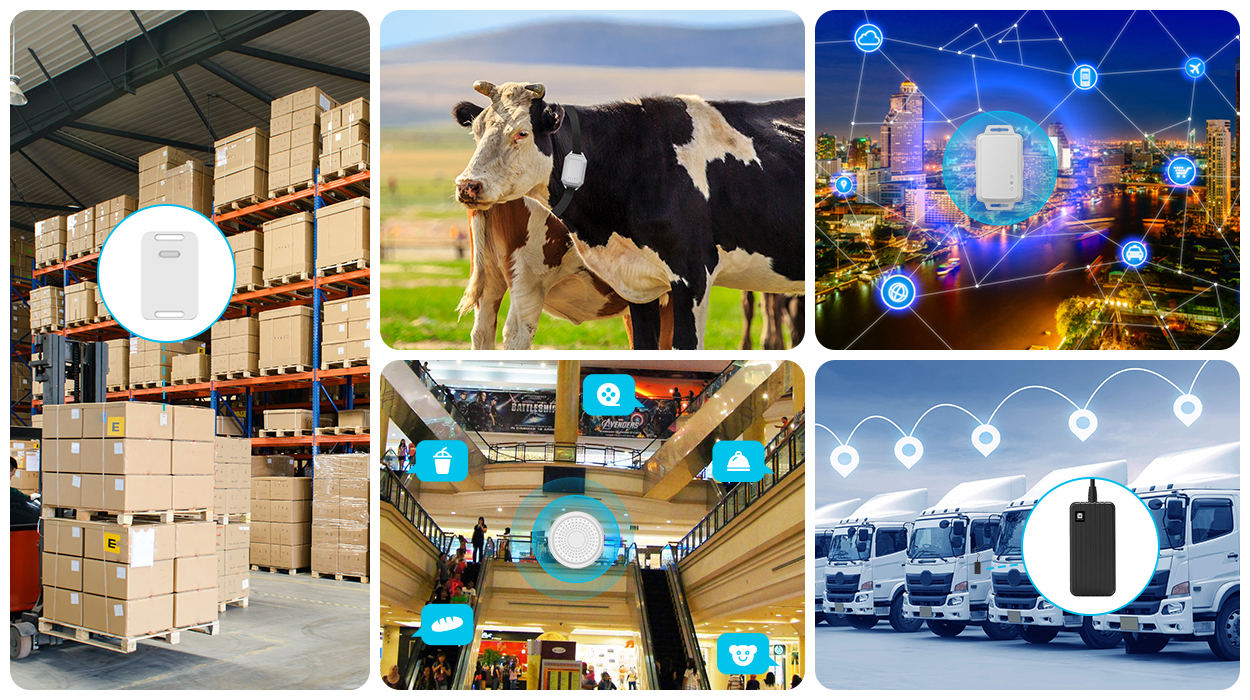
Tendências emergentes e desenvolvimentos futuros do rastreamento de ativos
O campo do rastreamento de ativos está em constante evolução, impulsionado pelos avanços nas tecnologias sem fio, IoT, AI, e análise de dados. Tendências emergentes estão moldando o futuro do rastreamento de ativos, revolucionando a maneira como as empresas rastreiam e gerenciam seus ativos valiosos. Uma tendência proeminente é a integração de múltiplas tecnologias para criar soluções de rastreamento híbridas. Combinando GPS, RFID, Bluetooth, e tecnologias celulares, as empresas podem obter maior precisão e confiabilidade no rastreamento de ativos em vários ambientes e casos de uso.
Outra tendência significativa é a adoção da computação de ponta, que aproxima o processamento e a análise de dados da borda da rede. Isso permite análises em tempo real e tomadas de decisão rápidas, amplificando a eficiência e eficácia gerais dos sistemas de rastreamento de ativos. Além disso, há uma ênfase crescente no fortalecimento das funcionalidades de segurança no rastreamento de ativos. Protocolos de criptografia, mecanismos de autenticação, e tecnologias à prova de adulteração estão sendo desenvolvidas para proteger ativos contra roubo, acesso não autorizado, e violações de dados.
Conclusão
Muitas vezes não há conflito direto entre diferentes tecnologias de rastreamento de ativos. Com alguma criatividade, é possível misturar, combinar, e utilizá-los de inúmeras maneiras valiosas. A solução MOKOSmart, que integra LoRaWAN, Wi-fi, e GPS, exemplifica essa abordagem.
A escolha da tecnologia para rastreamento de ativos depende do caso de uso específico. Por exemplo, equipar todas as caixas de um armazém com transmissores GPS pode não ser necessário. similarmente, confiar apenas em um beacon BLE pode não ser suficiente para rastrear ativos de alto valor, como remessas farmacêuticas ou contêineres de ferramentas valiosas.
Se você não tiver certeza sobre qual tecnologia de rastreamento de ativos empregar, MOKOSmart pode ajudá-lo. Existem inúmeras tecnologias disponíveis para explorar e considerar.
